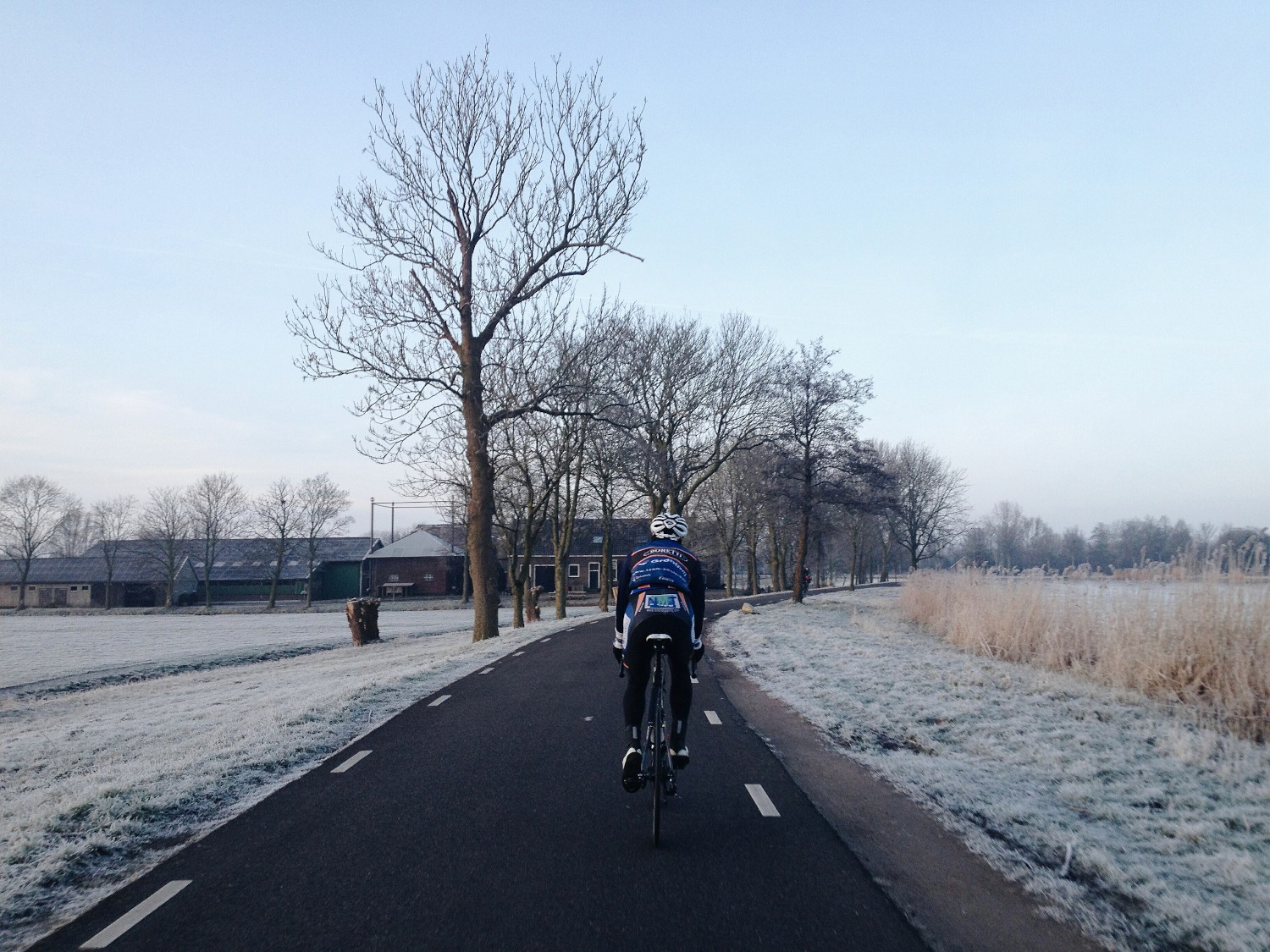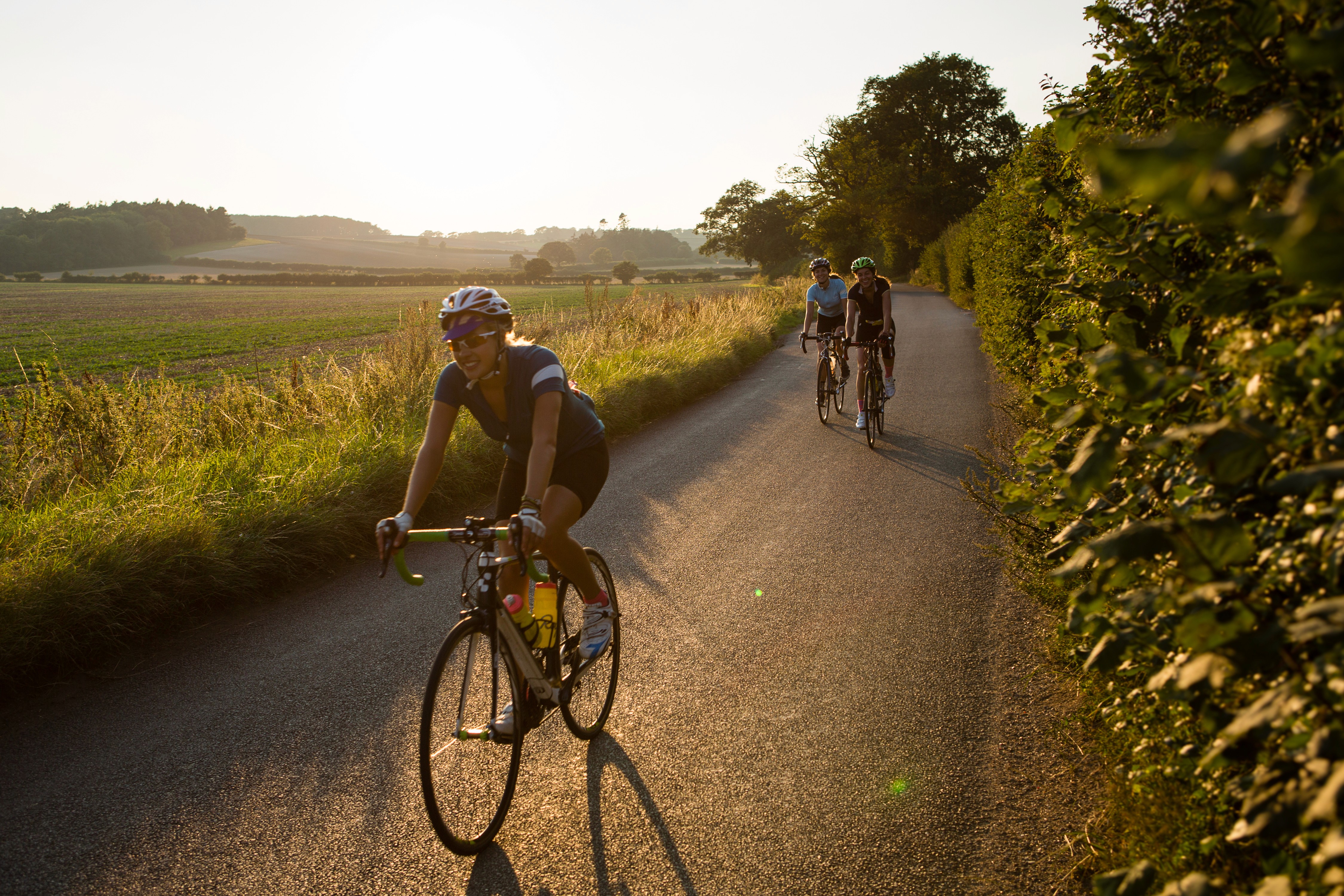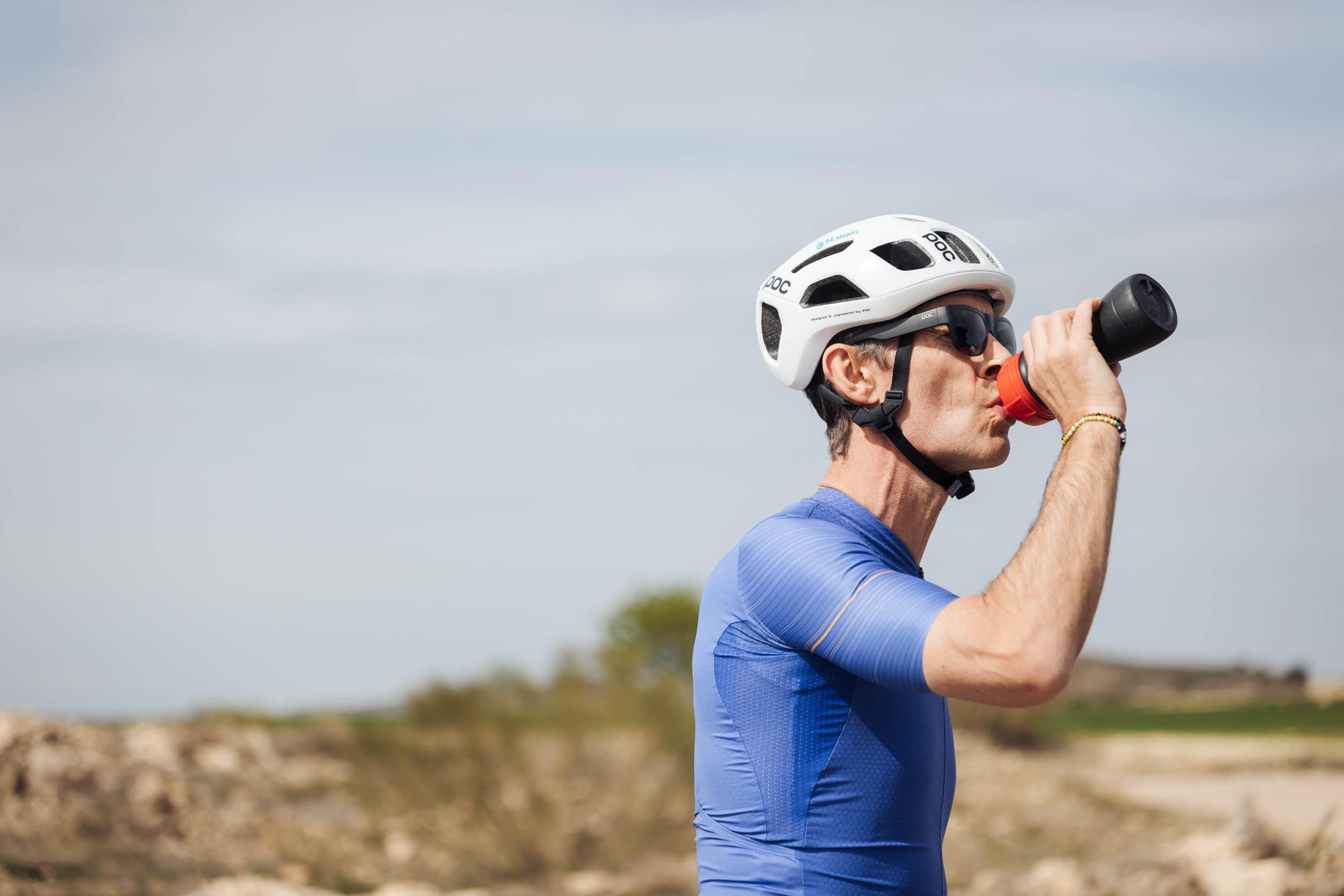Training in cold weather

Nov 12, 2020

Training in cold weather
Nov 12, 2020

Training in cold weather

Nov 12, 2020

It might not be that cold outside yet, but winter is coming. The extent to which we as cyclists suffer from this cold differs from person to person. One person might claim that you just need the proper cycling gear, while another only does indoor rides when the mercury drops. Apart from this subjective experience of cold, this weather type also clearly has an objective impact on the human body. We are often asked whether it is actually a good idea to train outside with temperatures around zero degrees Celsius. In this article we try to give clear and scientifically based answers.
Temperature is not the only measure for cold
Firstly, it is important to consider how cold it actually is. Just the temperature is not a good measure for this. As cyclists, we know better than anyone else what the influence of the wind is and the wind is indeed a crucial factor. Because of the wind, the human body cools down faster. Therefore, the wind chill, which takes into account the force of the wind, is a much better measure for cold. A temperature of just below zero with a clear blue sky and a beautiful sun seems fine at first glance.
However, with a Bft 4 wind from the east, the wind chill factor already drops the temperature to -9°C! And if you want to ride against that wind with a speed of 28 km/h, then the wind chill temperature is quite a bit lower still at about -13/-14°C. Temperatures so low have a big impact, so they should be taken seriously.
What happens with your body when you train in the cold?
At a wind chill temperature below -15°C, cold injuries may occur after just an hour. Frostnip or even frostbite damage (possibly irreversible) can develop as ice crystals form in the tissue of exposed body parts, like fingers, toes, ears and/or nose. But even before that happens, other interesting reactions can already be seen in the human body. Vasoconstriction occurs to keep the core temperature at the required level. This protects the torso, where all vital organs lie, but constricts the blood flow to arms and legs.
So cycling in the cold means that the leg muscles get delivered significantly less blood and therefore less fuel and oxygen. And the disposal of waste products like lactic acid is also considerably reduced. Therefore, in temperatures around zero degrees Celsius, you will never be able to perform as well as in warmer weather. More interestingly, it makes the load on your body heavier than at higher temperatures, while the heart rate monitor or power meter might still suggest an equal performance. It is therefore important to realize that the level of effort for a given power level is considerably higher at low temperatures.
Does training in the cold speed up your metabolism?
However, contrary to popular belief, the metabolism of exercise in the cold is not automatically higher than normal. The thinking is often that an increased metabolism burns more fats and carbohydrates and also thereby releases more heat. Nice idea, but for an increased metabolism, humans actually have to make more effort through increased muscle activity. This is, for example, what happens when you are shivering. As long as the core temperature is not compromised, because you wear the proper clothes to brave the cold, you will not sit shivering on the bike. In contrast to some animal species, humans do not have the ability to produce more heat due to increased activity of tissue other than muscle tissue. A bear, for instance, can turn up his internal "stove" a little bit during his hibernation. The popular belief likely developed from the fact that if you had dressed up in quite a few layers of winter clothing, your ease of movement was compromised and you had to work harder, thereby seeing a higher metabolism.
Why cyclists are the least capable of keeping their body temperature at a constant level
As mentioned, the body does everything it can to keep the temperature at a constant high level of at least 36°C. We as cyclists actually have all the possible factors that can complicate this working against us. The elements such as rain and wind play an important role. In addition, a low fat percentage also significantly complicates this task and research shows that well-trained individuals are no better at maintaining their core temperature than less trained people. By the way, cyclists over 60 face another hurdle, because the vasoconstriction works less at older age. Women have a small advantage in this context because on average their fat percentage is higher. But at the same fat percentage, women have a harder time again because on average the ratio between mass and surface is lower.
What do you need to wear as a cyclist in the cold?
To help the body the best way is to create as many layers of clothes as possible. And two thin layers is always better than one thick layer. Although in cycling everything should always be as tight as possible given the importance of aerodynamics, the opposite is now the case. In this way, stagnant layers of air are created that adopt the temperature of the body. But things go wrong when overdoing it by wearing too much warm clothing, that also is not breathing very well. In that situation, water vapor generated by the body during exercise cannot find a way out. This causes the clothing directly on the skin to get wet. And riding back home for an hour or so with clothes that have become wet during some strenuous intervals is really a problem. These are precisely those situations where extra vigilance is required.
By the way, modern apparel fabrics make this cold management a lot easier than 20 years ago, but still it is important to think about it seriously and experiment. Finally, an underestimated element of cold weather training is the fluid intake. Because of the cold, there is less of an urge to drink. But in winter, quite a bit of water vapor escapes during hard efforts. Especially when the air is really dry, it is very possible to dehydrate. So please pay attention to the fluid balances. If you struggle taking swigs of cold fluid, consider insulated bidons with tea or other hot drinks.
Adjust to the cold!
Finally, the effects of acclimatization to the cold in the physiological field are quite limited. There is a small acclimatization, where the body learns to apply vasoconstriction a little faster and also heat production by muscle contraction is at a slightly higher level. The most important advice is to use common sense when riding in the cold, listen to your body and adjust the effort/distance to the conditions.
It might not be that cold outside yet, but winter is coming. The extent to which we as cyclists suffer from this cold differs from person to person. One person might claim that you just need the proper cycling gear, while another only does indoor rides when the mercury drops. Apart from this subjective experience of cold, this weather type also clearly has an objective impact on the human body. We are often asked whether it is actually a good idea to train outside with temperatures around zero degrees Celsius. In this article we try to give clear and scientifically based answers.
Temperature is not the only measure for cold
Firstly, it is important to consider how cold it actually is. Just the temperature is not a good measure for this. As cyclists, we know better than anyone else what the influence of the wind is and the wind is indeed a crucial factor. Because of the wind, the human body cools down faster. Therefore, the wind chill, which takes into account the force of the wind, is a much better measure for cold. A temperature of just below zero with a clear blue sky and a beautiful sun seems fine at first glance.
However, with a Bft 4 wind from the east, the wind chill factor already drops the temperature to -9°C! And if you want to ride against that wind with a speed of 28 km/h, then the wind chill temperature is quite a bit lower still at about -13/-14°C. Temperatures so low have a big impact, so they should be taken seriously.
What happens with your body when you train in the cold?
At a wind chill temperature below -15°C, cold injuries may occur after just an hour. Frostnip or even frostbite damage (possibly irreversible) can develop as ice crystals form in the tissue of exposed body parts, like fingers, toes, ears and/or nose. But even before that happens, other interesting reactions can already be seen in the human body. Vasoconstriction occurs to keep the core temperature at the required level. This protects the torso, where all vital organs lie, but constricts the blood flow to arms and legs.
So cycling in the cold means that the leg muscles get delivered significantly less blood and therefore less fuel and oxygen. And the disposal of waste products like lactic acid is also considerably reduced. Therefore, in temperatures around zero degrees Celsius, you will never be able to perform as well as in warmer weather. More interestingly, it makes the load on your body heavier than at higher temperatures, while the heart rate monitor or power meter might still suggest an equal performance. It is therefore important to realize that the level of effort for a given power level is considerably higher at low temperatures.
Does training in the cold speed up your metabolism?
However, contrary to popular belief, the metabolism of exercise in the cold is not automatically higher than normal. The thinking is often that an increased metabolism burns more fats and carbohydrates and also thereby releases more heat. Nice idea, but for an increased metabolism, humans actually have to make more effort through increased muscle activity. This is, for example, what happens when you are shivering. As long as the core temperature is not compromised, because you wear the proper clothes to brave the cold, you will not sit shivering on the bike. In contrast to some animal species, humans do not have the ability to produce more heat due to increased activity of tissue other than muscle tissue. A bear, for instance, can turn up his internal "stove" a little bit during his hibernation. The popular belief likely developed from the fact that if you had dressed up in quite a few layers of winter clothing, your ease of movement was compromised and you had to work harder, thereby seeing a higher metabolism.
Why cyclists are the least capable of keeping their body temperature at a constant level
As mentioned, the body does everything it can to keep the temperature at a constant high level of at least 36°C. We as cyclists actually have all the possible factors that can complicate this working against us. The elements such as rain and wind play an important role. In addition, a low fat percentage also significantly complicates this task and research shows that well-trained individuals are no better at maintaining their core temperature than less trained people. By the way, cyclists over 60 face another hurdle, because the vasoconstriction works less at older age. Women have a small advantage in this context because on average their fat percentage is higher. But at the same fat percentage, women have a harder time again because on average the ratio between mass and surface is lower.
What do you need to wear as a cyclist in the cold?
To help the body the best way is to create as many layers of clothes as possible. And two thin layers is always better than one thick layer. Although in cycling everything should always be as tight as possible given the importance of aerodynamics, the opposite is now the case. In this way, stagnant layers of air are created that adopt the temperature of the body. But things go wrong when overdoing it by wearing too much warm clothing, that also is not breathing very well. In that situation, water vapor generated by the body during exercise cannot find a way out. This causes the clothing directly on the skin to get wet. And riding back home for an hour or so with clothes that have become wet during some strenuous intervals is really a problem. These are precisely those situations where extra vigilance is required.
By the way, modern apparel fabrics make this cold management a lot easier than 20 years ago, but still it is important to think about it seriously and experiment. Finally, an underestimated element of cold weather training is the fluid intake. Because of the cold, there is less of an urge to drink. But in winter, quite a bit of water vapor escapes during hard efforts. Especially when the air is really dry, it is very possible to dehydrate. So please pay attention to the fluid balances. If you struggle taking swigs of cold fluid, consider insulated bidons with tea or other hot drinks.
Adjust to the cold!
Finally, the effects of acclimatization to the cold in the physiological field are quite limited. There is a small acclimatization, where the body learns to apply vasoconstriction a little faster and also heat production by muscle contraction is at a slightly higher level. The most important advice is to use common sense when riding in the cold, listen to your body and adjust the effort/distance to the conditions.
It might not be that cold outside yet, but winter is coming. The extent to which we as cyclists suffer from this cold differs from person to person. One person might claim that you just need the proper cycling gear, while another only does indoor rides when the mercury drops. Apart from this subjective experience of cold, this weather type also clearly has an objective impact on the human body. We are often asked whether it is actually a good idea to train outside with temperatures around zero degrees Celsius. In this article we try to give clear and scientifically based answers.
Temperature is not the only measure for cold
Firstly, it is important to consider how cold it actually is. Just the temperature is not a good measure for this. As cyclists, we know better than anyone else what the influence of the wind is and the wind is indeed a crucial factor. Because of the wind, the human body cools down faster. Therefore, the wind chill, which takes into account the force of the wind, is a much better measure for cold. A temperature of just below zero with a clear blue sky and a beautiful sun seems fine at first glance.
However, with a Bft 4 wind from the east, the wind chill factor already drops the temperature to -9°C! And if you want to ride against that wind with a speed of 28 km/h, then the wind chill temperature is quite a bit lower still at about -13/-14°C. Temperatures so low have a big impact, so they should be taken seriously.
What happens with your body when you train in the cold?
At a wind chill temperature below -15°C, cold injuries may occur after just an hour. Frostnip or even frostbite damage (possibly irreversible) can develop as ice crystals form in the tissue of exposed body parts, like fingers, toes, ears and/or nose. But even before that happens, other interesting reactions can already be seen in the human body. Vasoconstriction occurs to keep the core temperature at the required level. This protects the torso, where all vital organs lie, but constricts the blood flow to arms and legs.
So cycling in the cold means that the leg muscles get delivered significantly less blood and therefore less fuel and oxygen. And the disposal of waste products like lactic acid is also considerably reduced. Therefore, in temperatures around zero degrees Celsius, you will never be able to perform as well as in warmer weather. More interestingly, it makes the load on your body heavier than at higher temperatures, while the heart rate monitor or power meter might still suggest an equal performance. It is therefore important to realize that the level of effort for a given power level is considerably higher at low temperatures.
Does training in the cold speed up your metabolism?
However, contrary to popular belief, the metabolism of exercise in the cold is not automatically higher than normal. The thinking is often that an increased metabolism burns more fats and carbohydrates and also thereby releases more heat. Nice idea, but for an increased metabolism, humans actually have to make more effort through increased muscle activity. This is, for example, what happens when you are shivering. As long as the core temperature is not compromised, because you wear the proper clothes to brave the cold, you will not sit shivering on the bike. In contrast to some animal species, humans do not have the ability to produce more heat due to increased activity of tissue other than muscle tissue. A bear, for instance, can turn up his internal "stove" a little bit during his hibernation. The popular belief likely developed from the fact that if you had dressed up in quite a few layers of winter clothing, your ease of movement was compromised and you had to work harder, thereby seeing a higher metabolism.
Why cyclists are the least capable of keeping their body temperature at a constant level
As mentioned, the body does everything it can to keep the temperature at a constant high level of at least 36°C. We as cyclists actually have all the possible factors that can complicate this working against us. The elements such as rain and wind play an important role. In addition, a low fat percentage also significantly complicates this task and research shows that well-trained individuals are no better at maintaining their core temperature than less trained people. By the way, cyclists over 60 face another hurdle, because the vasoconstriction works less at older age. Women have a small advantage in this context because on average their fat percentage is higher. But at the same fat percentage, women have a harder time again because on average the ratio between mass and surface is lower.
What do you need to wear as a cyclist in the cold?
To help the body the best way is to create as many layers of clothes as possible. And two thin layers is always better than one thick layer. Although in cycling everything should always be as tight as possible given the importance of aerodynamics, the opposite is now the case. In this way, stagnant layers of air are created that adopt the temperature of the body. But things go wrong when overdoing it by wearing too much warm clothing, that also is not breathing very well. In that situation, water vapor generated by the body during exercise cannot find a way out. This causes the clothing directly on the skin to get wet. And riding back home for an hour or so with clothes that have become wet during some strenuous intervals is really a problem. These are precisely those situations where extra vigilance is required.
By the way, modern apparel fabrics make this cold management a lot easier than 20 years ago, but still it is important to think about it seriously and experiment. Finally, an underestimated element of cold weather training is the fluid intake. Because of the cold, there is less of an urge to drink. But in winter, quite a bit of water vapor escapes during hard efforts. Especially when the air is really dry, it is very possible to dehydrate. So please pay attention to the fluid balances. If you struggle taking swigs of cold fluid, consider insulated bidons with tea or other hot drinks.
Adjust to the cold!
Finally, the effects of acclimatization to the cold in the physiological field are quite limited. There is a small acclimatization, where the body learns to apply vasoconstriction a little faster and also heat production by muscle contraction is at a slightly higher level. The most important advice is to use common sense when riding in the cold, listen to your body and adjust the effort/distance to the conditions.
More Relevant Articles
Discover valuable training tips to enhance your cycling performance.
More Relevant Articles
Discover valuable training tips to enhance your cycling performance.
More Relevant Articles
Discover valuable training tips to enhance your cycling performance.

Unlock Your Cycling Potential Today
Join thousands of cyclists who have improved their performance with JOIN's training plans.
Probeer het nu
Meer Informatie

Unlock Your Cycling Potential Today
Join thousands of cyclists who have improved their performance with JOIN's training plans.
By joining, you agree to our Terms and Conditions and our Privacy Policy.

Unlock Your Cycling Potential Today
Join thousands of cyclists who have improved their performance with JOIN's training plans.
By joining, you agree to our Terms and Conditions and our Privacy Policy.
Join Now
Join Now



